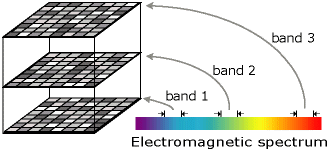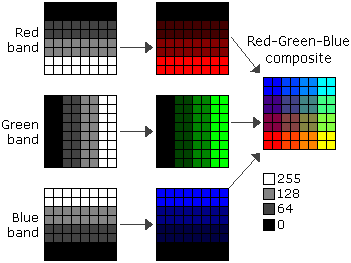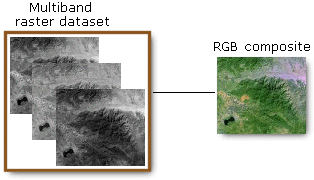Some rasters have a single band, or layer (a measure of a single characteristic), of data, while others have multiple bands. Basically, a band is represented by a single matrix of cell values, and a raster with multiple bands contains multiple spatially coincident matrices of cell values representing the same spatial area. An example of a single-band raster dataset is a digital elevation model (DEM). Each cell in a DEM contains only one value representing surface elevation. You can also have a single-band orthophoto, which is sometimes called a panchromatic or grayscale image. Most satellite imagery has multiple bands, typically containing values within a range or band of the electromagnetic spectrum.
There are three main ways to display (render) single-band raster datasets:
- Using two colors—In a binary image, each cell has a value of 0 or 1 and is often displayed using black and white. This type of display is often used for displaying scanned maps with simple line work, such as parcel maps.
- Grayscale—In a grayscale image, each cell has a value from 0 to another number, such as 255 or 65535. These are often used for black-and-white aerial photographs.
- Color map—One way to represent colors on an image is with a color map. A set of values is coded to match a defined set of red, green, and blue (RGB) values. For more information, see Key concepts of raster dataset color maps.
The three main ways to display single-band raster datasets are shown below.

When there are multiple bands, every cell location has more than one value associated with it. With multiple bands, each band usually represents a segment of the electromagnetic spectrum collected by a sensor. Bands can represent any portion of the electromagnetic spectrum, including ranges not visible to the eye, such as the infrared or ultraviolet sections. The term band originated from the reference to the color band on the electromagnetic spectrum.

When you create a map layer from a raster image, you can choose to display a single band of data or form a color composite from multiple bands. A combination of any three of the available bands in a multiband raster dataset can be used to create RGB composites. By displaying bands together as RGB composites, often more information is gleaned from the dataset than if you were to work with just one band.

A satellite image, for example, commonly has multiple bands representing different wavelengths from the ultraviolet through the visible and infrared portions of the electromagnetic spectrum. Landsat imagery, for example, is data collected from seven different bands of the electromagnetic spectrum. Bands 1–7, including 6, represent data from the visible, near infrared, and midinfrared regions. Band 6 collects data from the thermal infrared region. Another example of a multiband image is a true color orthophoto in which there are three bands, each representing either red, green, or blue light.
